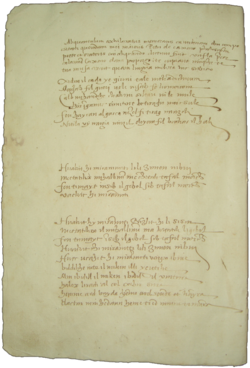
Pietru Caxaro or Caxaru [a] (died c. August 1485), also known in English as Peter Caxaro, was a Maltese notary, orator, politician, philosopher, and poet. He wrote the poem Cantilena , the earliest known text in the Maltese language and the only one in Medieval Maltese. Caxaro is, to date, Malta's first philosopher, according to Mark Montebello.
Contents
- Biography
- Sources
- Life and career
- Personal life
- Rediscovery
- The Cantilena
- Text
- Transcript
- Analysis
- Philosophy
- Notes
- References
- Bibliography
- Books
- Journals
- News articles
- External links
Little about Caxaro's life is known. Born in Mdina sometime in the early fifteenth century, Caxaro studied to become a notary and attained his qualification in 1438. He served as a judge in the civil and ecclesiastical courts for much of his life. He was also a member of the Mdina town council and appears to have been a skilled orator. Caxaro died in 1485, remaining all but forgotten for the next four centuries.
In 1966, the historian Mikiel Fsadni unearthed a Maltese language poem attributed to Caxaro, christened the Cantilena. The discovery was surprising, since, at the time, the oldest known poem in Maltese dated to the seventeenth century, and hardly any references to Maltese from the Middle Ages beyond placenames were thought to exist. Fsadni and fellow historian Godfrey Wettinger introduced the Cantilena to the public in 1968. Since then, many linguistic and literary studies on the poem have been composed. Scholars emphasise the blend of Arabic and Italian/Sicilian influences on the Maltese language that features in Caxaro's work and the humanistic philosophy it communicates. In 2025, UNESCO added the Cantilena to its Memory of the World Register, only the second Maltese artefact to receive such recognition.




